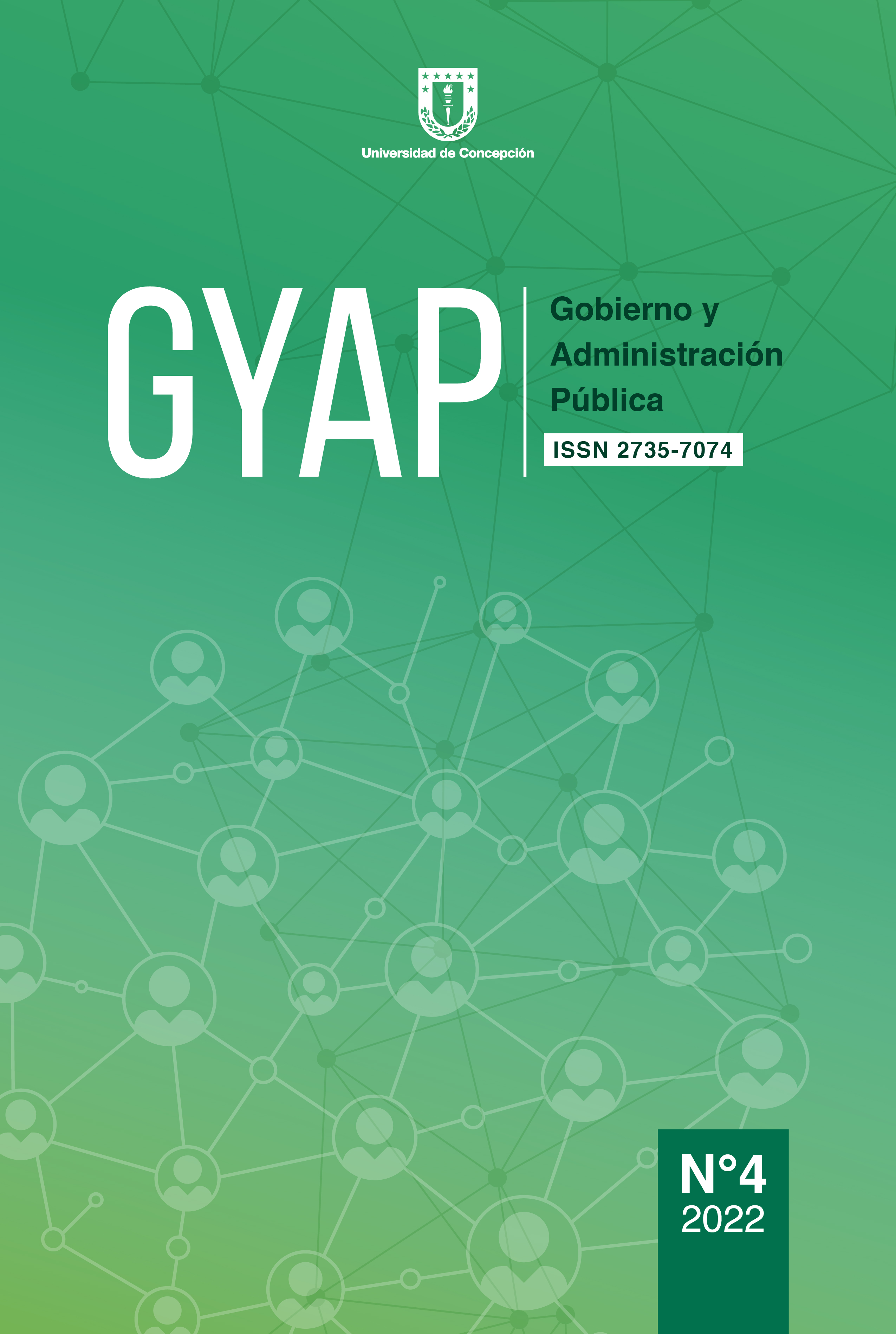The role of intersectoriality in extreme poverty policies in Chile: The case of the family program in the chilean social protection system
DOI:
https://doi.org/10.29393/GP4-10RIMB10010Keywords:
intersectoriality, poverty, Intersectorial Management, Social Protection, Social PolicyAbstract
Intersectoriality has been internationally recognized as an integral management model necessary to address the policies of the Social Protection System that seek to reduce the effects of the multi-causality of social problems. In this regard, the main challenge today lies in its implementation, so it is essential to know, for the Chilean case, how it works, as well as which are the factors that mediate its success, in order to generate feedback for its subsequent implementation. For this reason, this article seeks to answer these questions by taking the case of the Families Program, which seeks to overcome one of the greatest global challenges, such as extreme poverty.
In this way, we will review the proposals of different authors who, despite the little data that still supports intersectoriality, have problematized on it around the factors that affect intersectoriality, delving into the pro-integrity coordination, with its technical and political approaches proposed by Fabián Repetto (Repetto, 2009b, 2009a, Repetto et al., 2015), or from the approaches of communication and collaboration as factors developed by authors such as Winkworth & White (2011), Cunill-Grau (2014b), Corbett & Noyes (2008), all within the framework of the intersectoral role in social policies. Thus, the intersectoral role is related to the functioning of the Families Program from the logic of vulnerability and poverty, as well as in relation to the different components that outline the policy.
Downloads
References
Asociación de Municipalidades de Chile (2018). Informe de Capital Humano Municipal 2018 (p. 48). https://amuch.cl/wp-content/uploads/2022/05/Capital-Humano_VF5.pdf
Biblioteca del Congreso Nacional [BCN]. (2009). Historia de la Ley N° 20.379. Crea el Sistema Intersectorial de protección Social e institucionaliza el Subsistema de Protección Integral a la Infancia, Chile Crece Contigo. https://www.bcn.cl/obtienearchivo?id=recursoslegales/10221.3/3823/1/HL20379.pdf
Bronzo, C. y Repetto, F. (2015). Coordinación de políticas sociales: desafíos para la gestión pública. Colección Estudios N° 18, Serie Análisis, Área Protección Social, EUROSOCIAL, Programa para la Cohesión Social en América Latina, Madrid. http://sia.eurosocial-ii.eu/files/docs/1453800699-estudio_18.pdf.
Comisión Económica para América Latina y el Caribe (2015). Desarrollo social inclusivo: Una nueva generación de políticas para superar la pobreza y reducir la desigualdad en América Latina y el Caribe. https://hdl.handle.net/11362/39100.
Cohen, E., & Franco, R. (2005). Gestión social: Cómo lograr eficiencia e impacto en las políticas sociales. CEPAL, Serie Economía y Demografía. https://hdl.handle.net/11362/1863.
Corbett, T., & Noyes, J. (2008). Human services systems integration: A conceptual framework (Vol. 1333). Madison, WI: Institute for Research on Poverty.
Cunill-Grau, N. (2014a). La intersectorialidad en las nuevas políticas sociales: Un acercamiento analítico-conceptual. Gestión y política pública, 23(1). 5-46. http://www.scielo.org.mx/scielo.php?script=sci_arttext&pid=S1405-10792014000100001&lng=es&tlng=es.
Cunill-Grau, Nuria. (2014b). Resistencias a la Colaboración Interinstitucional: Aprendizajes para la Implementación de las Nuevas Políticas Sociales. Documentos y aportes en administración pública y gestión estatal, (23), 07-32. http://www.scielo.org.ar/scielo.php?script=sci_arttext&pid=S1851-37272014000200001.
De Gialdino, I. V. (2006). Estrategias de investigación cualitativa. Editorial Gedisa.
Decreto 30, de 2012. Aprueba Reglamento de la Ley N°20.595 sobre Transferencias Monetarias y el Bono de Protección. 07 de septiembre de 2012. https://www.bcn.cl/leychile/navegar?i=1044218&f=2012-09-29.
Decreto 34, de 2012, Aprueba Reglamento de Ley N°20.595, sobre Subsistema de Protección y Promoción Social Seguridades y Oportunidades, 7 de diciembre de 2012. https://www.bcn.cl/leychile/navegar?i=1046575&f=2012-12-07.
Dulzaides Iglesias, M. E., & Molina Gómez, A. M. (2004). Análisis documental y de información: dos componentes de un mismo proceso. ACIMED, 12(2). http://scielo.sld.cu/scielo.php?script=sci_arttext&pid=S1024-94352004000200011
Echebarria, K. (2001). Capital social, cultura organizativa y transversalidad en la gestión pública. VI Congreso Internacional del CLAD sobre la Reforma del Estado y de la Administración Pública, Buenos Aires, Argentina, 5-9 Nov. 2001. https://fcp.uncuyo.edu.ar/upload/La_modernizacin_del_Estado_y_de_la_Gestin_Pblica.pdf
Encuesta de Caracterización Socioeconómica Nacional [CASEN]. (2017). Observatorio Social: Encuesta de Caracterización Socioeconómica Nacional. Ministerio de Desarrollo Social y Familia. http://observatorio.ministeriodesarrollosocial.gob.cl/encuesta-casen-2017.
Esping-Andersen, G. (1993). Las tres economías políticas del Estado de bienestar. Desarrollo Institucional y Conflicto, (pg. 229-266). Banco de Desarrollo de América Latina.
FOSIS. (2017). Decreto N°0360—Convenio de transferencias para ejecución de la modalidad de Acompañamiento Psicosocial 2017 de la Municipalidad de Puerto Aysén.
González, M. del C., & Tarragó Montalvo, C. (2008). Capacitación para el cambio. ACIMED, 17(4), 0-0. http://scielo.sld.cu/scielo.php?script=sci_arttext&pid=S1024-94352008000400002
Hernández Sampieri, R., Fernández Collado, C., & Baptista Lucio, M. (2014). Capítulo 9 Recolección de datos cuantitativos. R. Hernández Sampieri, Metodología de la investigación, 20194-267.
Holzmann, R., & Jorgensen, S. (2003). Manejo social del riesgo: Un nuevo marco conceptual para la protección social y más allá. Revista Facultad Nacional de Salud Pública, 21(1), Article 1. https://revistas.udea.edu.co/index.php/fnsp/article/view/816.
Ley N° 20.379, de 2009, Crea el Sistema Intersectorial de Protección Social e institucionaliza el Subsistema de Protección Integral a la Infancia “Chile Crece Contigo”, 01 de septiembre de 2009. Última Modificación 15 de marzo de 2022. https://www.bcn.cl/leychile/navegar?idNorma=1006044
Mardones Z, R. (2008). Descentralización: Una definición y una evaluación de la agenda legislativa chilena (1990-2008). EURE (Santiago), 34(102), 39-60. https://doi.org/10.4067/S0250-71612008000200003
Ministerio de Desarrollo Social & Programa de las Naciones Unidad para el Desarrollo. (2019). Evolución de la pobreza 1990-2017 ¿Como ha cambiado Chile? (p. 92). https://www.estudiospnud.cl/informes-desarrollo/evolucion-de-la-pobreza-1990-2017-como-ha-cambiado-chile/.
Ministerio de Desarrollo Social y Familia (s.f.). Sistema de Protección Social. https://www.desarrollosocialyfamilia.gob.cl/proteccionsocial#:~:text=Es%20el%20subsistema%20de%20protecci%C3%B3n,alguna%20vulnerabilidad%20mayor%3A%20%E2%80%9Ca%20cada.
Ministerio de Desarrollo Social y Familia (2016). Informe final de evaluación programa familias en situación de pobreza extrema y vulnerabilidad. https://www.dipres.gob.cl/597/articles-149528_informe_final.pdf
Ministerio de Desarrollo Social y Familia (2017a). Informe de Seguimiento de Programas Sociales, Programa Familias 2017. https://programassociales.ministeriodesarrollosocial.gob.cl/pdf/2017/PRG2017_5_100063381.pdf
Ministerio de Desarrollo Social y Familia. (2017b). Metodología Programa Familias. https://www.desarrollosocialyfamilia.gob.cl/storage/docs/OT_REX_0827.pdf
Ministerio de Desarrollo Social. (2018). Situación de pobreza: Síntesis de resultados CASEN 2017. http://observatorio.ministeriodesarrollosocial.gob.cl/casenmultidimensional/casen/docs/Resultados_pobreza_Casen_2017.pdf
Potenza Dal Masetto, F., & Repetto, F. (2012). Sistemas de protección social en América Latina y el Caribe: Argentina. Comisión Económica para América Latina y el Caribe https://hdl.handle.net/11362/4028.
Repetto, F. (2009a). Coordinación de Políticas Sociales: Abordaje Conceptual y Revisión de Experiencias Latinoamericanas. 38, Los desafíos de la coordinación y la integralidad de las políticas y gestión pública en América Latina (pp. 41-84). Proyecto de Modernización del Estado.
Repetto, F. (2009b). Retos para la coordinación de la política social: Los casos de la descentralización y la intersectorialidad. En Gestión de la política social, conceptos y herramientas (pp. 169-200). Prometeo Libros. https://consejopsuntref.files.wordpress.com/2017/08/repetto-fabian-retos-para-lacoordinacic3b3n-de-la-polc3adticas-social.pdf
Repetto, F. (2010). Protección social en América Latina: La búsqueda de una integralidad con enfoque de derechos. Revista del CLAD Reforma y democracia, (47), 89-139. https://www.redalyc.org/pdf/3575/357533679004.pdf
Repetto, F. (2015). La economía política de las políticas sociales y la dimensión políticoinstitucional de los procesos de coordinación prointegralidad. En Coordinación de las políticas sociales: Desafíos para la gestión pública. EuroSocial.
Repetto, F., & Acuña, C. (2006). La institucionalidad de las políticas y los programas de reducción de pobreza en América Latina | Banco Interamericano de Desarrollo. https://publications.iadb.org/publications/spanish/document/La-institucionalidad-delas-pol%C3%ADticas-y-los-programas-de-reducci%C3%B3n-de-pobreza-enAm%C3%A9ricaLatina.pdf.
Repetto, F., Cunill-Grau, N., & Bronzo, C. (2015). Coordinación intersectorial pro integralidad de las instituciones de protección social. En Instrumentos de protección social: Caminos latinoamericanos hacia la universalización. (pp. 407-444). Programa EUROsociAL. http://sia.eurosocial-ii.eu/files/docs/1453800699-estudio_18.pdf.
Robles, C. (2011). El sistema de protección social de Chile: Una mirada desde la igualdad. CEPAL, Serie Documentos de Proyectos, N° 428. https://hdl.handle.net/11362/3907
Subsecretaría de Desarrollo Regional y Administrativo (11 de marzo de 2014). Programa de Gobierno Michelle Bachellet 2014-2018. http://www.subdere.gov.cl/sala-deprensa/programa-de-gobierno-michelle-bachelet-2014-2018-2
Winkworth, G., & White, M. (2011). Australia’s Children ‘Safe and Well’? 1 Collaborating with Purpose Across Commonwealth Family Relationship and State Child Protection Systems. Australian Journal of Public Administration, 70(1), 1-14. https://doi.org/10.1111/j.1467-8500.2010.00706.x
Published
How to Cite
Issue
Section
Copyright (c) 2023 Marianne Barril

This work is licensed under a Creative Commons Attribution 4.0 International License.










